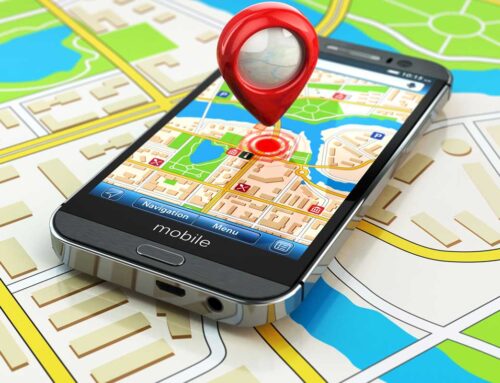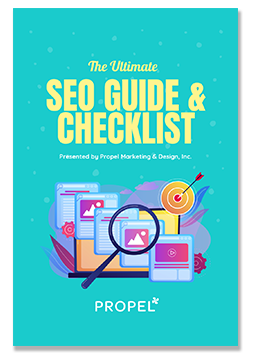Search engine optimization, otherwise known as SEO, we know, sounds scary. Fun fact: it isn’t scary. It isn’t complicated. It isn’t hard. If you know what you’re doing, of course. And we do!
So, we’d like to tell you all about how you (yeah, YOU) can gain control of your SEO-game and get some higher rank, really making your SEO work for you, without having to depend on any tech savviness whatsoever.
By staying focused on your buyer persona, your content (which we all know is king, afterall), and some simple optimizing, you have the power to conquer SEO.
If you’re just creating your website (or wanting to make changes to your existing website), your Content Management Systems (CMS) will make all the difference. Your CMS is the website platform that allows you to create, edit, organize, and publish content.
Some of the big CMS platforms include:
All of these are excellent platforms for hosting excellent content. Website builders are making it easier than ever to edit and publish content on their sites, so you don’t have to feel alone in this- they’re here to help.
So, let’s start going over these non-technical strategies to improve your SEO!
Things to have handy for this SEO lesson: you, your computer… ummmm, yeah, I think that’s about it.
Let’s do this.
Content and Blogging
Okay, okay, we know that you know this already, but it’s worth a refresher because it’s crazy-important. Your content will 100% ruin you if it’s not good.
No matter how well optimized your pages, if your content is louzy, Google (and the others) will not like you. This means a low ranking is your high-bar. No one wants that.
How do you achieve high-quality content? Somewhat easily actually.
When was the last time you updated your website? If it’s been over a year- jump on in and give it a tweak.
Think about new content ideas, perhaps you need to offer a new tab or two. Google likes to see more pages, rather than fewer within a website. How can you beef it up? New services? New testimonials? New images? Videos? Calendars? Resources?
The goal is to give your users a reason to keep coming back to your pages, right? By providing relevant, informative, interesting, engaging content you’ll also be providing your users with that reason.
Think about how long your target (website visitors) will be on your website. The search engines like to see your users stay for a bit (this is called their dwell time). The longer they stay, the better your rankings.
And write FOR your readers. Readability is a thing. If you’re a scientist and don’t speak well to your target audience, you’ll lose them. Think about who’s coming to your site and how they want to be spoken to (this is part of knowing your buyer persona).
Consider a blog if you don’t have one. This is a really powerful tool for your SEO. A blog will not only give you some credibility, but it adds to your website page count, gives users a reason to stay on your site (dwelling), and can garner relationships and loyalty through dialogue, comments, and shareability.
All of this will benefit your rankings. Blogging provides new info on the regular, so if it’s a good blog, you’re getting an audience on the regular.
It also allows you to rank for keywords, gives you a place for linking, provides a space for images and videos that can be optimized for SEO, offers guest blogging (use bloggers who may be making noise in your industry and leverage that)… I think you get it. Blogging is a big plus.
Blog tip: If you don’t have time to commit to a regular blog, no sweat. Consider hiding post dates and use older blogs like new. You may need to put a tiny bit of time in if anything has changed since the blog was written. After you give it a refresher, you’re good to go. Just be sure you’re only providing the most up-to-date material.
And feel free to repurpose old (or new) blogs as articles or newsletters (again, be sure they’re up-to-date).
(We’ll go over those blogging benefits in more detail later on in this post- don’t fret.)
Point being: a blog is an exceptional benefit to your content, therefore to your ranking.
Keywords
How people search for you is all you need to know in order to kill it at your keyword choices. Think about how you’d search for you, ask your friends and family how they’d search for you, look at your competition, what are their keywords?
Think about the long-tail keyword phrases (3-4 words) that users are typing in to find you.
Whatever those keywords are, those are the words to use within your website. But pay close attention here- Google is super smart and will know if you’re stuffing these words in. Don’t do that. Your content still needs to be of the highest quality.
Use your keywords in titles, headers, tags, and image captions. When your keywords match a query, your website will have a good chance of ranking higher.
Image Optimization
Images and photos are really taking off when it comes to SEO. People are image-centric. We want to see what we’re gonna be reading about. If we connect with an image, we’ll read on, but if we don’t, we may flee. That’s why it’s important to have great images on your website.
So, the fatal flaw: businesses put a ton of time, money, and effort into finding or taking or buying the right images and although their sites look magical, the images don’t get optimized, so they were all for naught (when it comes to SEO).
Optimizing images may sound tricky, but trust us when we tell you, it’s not.
Look at your images’ file format and size. Not optimizing for image size can take a huge toll on your page’s load time. If it takes a page too long to load, you’ll lose a user/buyer/loyal customer/follower/referral.
The easy fix is to compress each image. There are dozens of tools that will help you with this, and many are free, and all are easy. Step-by-step guidance will allow you to resize images quickly and efficiently.
And don’t forget to use your keywords when naming, titling, and captioning/describing your images. Google doesn’t see images, so it needs you to tell it what they are. Don’t get lazy here!
Say you have a lotion store and you name an image simply “body lotionA” you’re missing out on some targeting. Think more along the lines of “heavy cream body lotion for aging skin”. See the difference?
Videos and Audio
While we’re on the subject of images, let’s talk videos and audio, shall we? Turns out, people really like ‘em. When people like things, those things rank better.
Adding videos and audio to your website is a huge win because it’s just plain easier to watch or listen to something than it is to read about it. But for SEO purposes, it pays off with some great dwell time.
And don’t think you need to get all into crazy tech stuff here. You’ll find step-by-step instructions on how to upload a video or audio to your site on just about every website building platform out there.
As far as taking a video, your cell phone will most likely work just fine. No need for a crew, or lighting and sound investments. All of that depends on your product and your budget, but smartphones are pretty darn good these days when it comes to video-taking.
Like with your images, video keyword optimization is available and should not be forgotten.
All the Linking
You want to look credible and a great way to achieve that is by outbound linking. Whenever you use a quote, or a stat, make a reference to someone else’s work, etc., give that info its props and link to it.
This helps two-fold. First, outbound linking to authoritative sources shows that you know who to go to for your information (adds to your reliability), but also you can create a relationship with that source, meaning the source may link to you from time to time, too.
Be sure you use only trustworthy sources that provide recent information. The search engines love this.
And, hey, do you want someone to link to you- ask. It’s that simple. Send an email or reach out on social media and plead your case. What’s the worst that can happen?
Linking internally is also a win. If you’re providing content that some may need elaborated upon, send them to a past blog post you wrote or to another page on your site that’ll help them out. Again, great for your SEO.
When dealing with links, you want to take care that all of your links are working. It’ll look pretty bad if your user thinks they’re going to get some insight to a question based on the link you’ve shared, but instead get sent to an invalid location.
An easy tool to be sure your links are good is Dead Link Checker. It will inform you of any links that aren’t working and if you have an account with them, they’ll stay on top of it, letting you know as soon as a link is no longer valid.
Go Mobile
Smartphones are the new computer. In fact, last year 52.2% of all website traffic worldwide was generated through mobile phones.
You know this, and so does Google. That means Google wants your website to be mobile-friendly. You gotta do this right now if you’re not currently readable through handheld devices.
There’s no tech wizardry involved, promise. Your website host will have easy-to-follow guidance on how to create web pages that work on mobile, making changing it up as simple as switching website themes.
We recommend that you make the move to a responsive website theme.
Don’t stress, you’re not reinventing the wheel here. It’s not going to be nearly as difficult or time-consuming as you think. Your host will do almost everything for you and you can agree or disagree. If you don’t approve of something, you can delete it or move it accordingly.
If possible, do all this mobile optimization from your computer, not your mobile device. Note that you’ll be able to view exactly how your pages will look on a phone while doing this, even though you’re working from a computer.
Page Format
This is one of the simplest rules for your website’s SEO, therefore is often an afterthought. So, don’t let it be. Put some time in when designing your pages. Be neat and clean, with a site architecture and navigation that’s easy to follow and makes sense.
People long for organization and don’t want to come to a cluttered page where they can’t find what they want. If you’re looking for a high bounce-rate, have a too-busy page.
Things to take into consideration when your formatting your pages:
- Font- size, typography, color
- Headers, subheads, and bullet points for separation and ease of read
- Amount of text
- Images and videos
- Contact information (this deserves its own section, it’s that important, see next header)
If your page has just too much going on, it will come off as spammy and untrustworthy. You know the sang “cleanliness is next to SEO-iness”, right?
Contact info
You know what would really suck? If you lost a customer because they couldn’t figure out how to reach you. Yikes.
Don’t make that mistake. Your contact information should be easy to find and as clean as possible, showing your phone number, location (if applicable), and email address. And if you’re on social media- yep, that should be there, too.
Users will report you as spam if you don’t have this info available. You don’t want that to happen because that will kill all of your SEO efforts.
Social Media
Ohhh, don’t fight it. It’s here and it’s staying, so you need to get involved. At least your biz does. Your social media accounts can really help boost your SEO ranking.
Everyone is on some form of it, so think of all the advertising you’re doing without spending a dime. Not to mention, it gives buyers a sense of security when they see all your posts and reposts and likes and friends.
Users can share links to your website on social media and that’s a solid SEO victory. You can share links on your social media profiles, too. Take advantage of this by adding all the social media icons to your web pages. People like one-click sharing.
Titles, URLs, and Meta Descriptions
The title you create for the search engines should have the following characteristics:
- Short, sweet, under 65 characters (you don’t want it to get cut off)
- Keywords in the forefront
- Title should be consistent with what the page is offering
- Focused and concise
- Poignant and affecting, emotional
Your URL has no room for emotion, or chaos. Make it clear and easy to remember, ideally it will have some part of your title involved. Don’t use the emotional part of your title in your URL, use the keyword part.
Your meta description should be descriptive with relevant keywords found up front. Ask yourself who, what, why, when, where, and how- then write. Each meta description needs to be unique per page and should be under 160 characters.
When these things all work together, they make beautiful SEO music.
Q&A Sites
These excite us! Everyone loves a good question and answer space! You should be there. You know your stuff, that’s why you created a business. Go answer some Qs.
When you comment on Q&A sites, you’re setting yourself up as an authority in your industry, while adding value for your target audience. If you show your peeps that you have knowledge, they’ll head to your website for more.
Yahoo! Answers and Quora are great places to start and really well traveled. When you answer a question, be sure to write well (think grammar and spelling here), make sure you’re accurate, and if possible, link to yourself (a blog or web page).
Only link when appropriate! This is important. You don’t want to come off as spammy. If people like what you have to say, you’ve just gotten a slew of more visitors to your site.
Infographics
Now here’s a great way to generate some SEO goodness. Users love these guys. And as said in the past- users love it, Google loves it.
When you create an infographic you want to combine top-notch design with top-notch content. Don’t put the time in if you’re not providing valuable and reliable info, no matter how good it looks.
Let me reiterate, if your content isn’t good, your infographic will (likely) fail, so be sure to combine your infographic with awesome content.
Because Google doesn’t index the text on the infographic, coupling it with a longform content strategy here (around 2000 words of quality verbiage) will help you get some push in ranking power.
And, if possible, make your graphic move. That’s right. You can make them move. Love this. And oh, the sweet, sweet sound of link-sharing begins.
Get Involved (and tell everyone)
Are you being interviewed for anything? Are you a trailblazer and the press needs to hear your story? Are you involved in a charity? Perhaps you’re hosting an event?
All of these are tremendous ways to gain exposure. If you sign up to give a lecture, guess what? Your information has just been broadcast to all of those people attending said lecture. And the masses will want to learn more about you and head straight to your website.
On an upcoming podcast? The host is shouting it out. And that means people will check out who you are and why you’re gonna be on the show.
Get it? The more involved you get, the better. This is sometimes called offline SEO, but it’s a big power play and should become a part of your SEO strategy.
Google My Business
This one’s a good one for all, but if you’re a brick-and-mortar especially! Take a sec and set up your Google My Business account.
This will benefit your local SEO immensely by giving you access to edit your business’s info, allowing verification of contact info, adding images, monitoring your reviews, and you can connect with your customers on Google Search and Maps.
If your competition is doing this, they’ve got a leg up on you, so jump on this ASAP. It’s sooooo easy!
Influencing
If you want to really make a statement, have an influencer endorse you. Now, this can get tricky. If you want to stand out, so as to be seen by the influencer, don’t just send over your info and ask him/her to tell their followers.
Give the influencer a reason to want to support your brand. Help them to create a better blog. A better tweet. A better infographic. You can do this through comments, reposts, email. But whatever you do, be sincere and kind, and give valuable feedback.
Another route: create agreeable content that the influencer would endorse and post it on his/her Facebook or Twitter page. Even if the influencer doesn’t respond, those who follow him/her will see your content, and chances are good, you’ll get some action from it.
Once you have an influencer in your corner who does the selling for you, you’ll see a huge increase in website visits.
Conclusion
Well, there you have it. SEO magic without the techiness. If you take these steps to help promote your website, you’ll see an increase in traffic. And more importantly, your traffic will be your target audience.
Here’s the breakdown- and if you follow these clever little steps you’ll ensure SEO success:
- Identify and connect with your target audience
- Modify (or create) your website to be super user-friendly, creating an atmosphere of valuable info
- Promote your website content in all the right ways
If this is all a bit much for you, just start with a couple of the easier steps that will boost you in rank. You don’t have to do all of this today. SEO isn’t going anywhere. And always remember to keep track of your results so you know what’s working and what isn’t.




![How to Write a Professional Chiropractic Bio [Template Included]](https://propelyourcompany.com/wp-content/uploads/write-a-bio-500x383.jpg)

